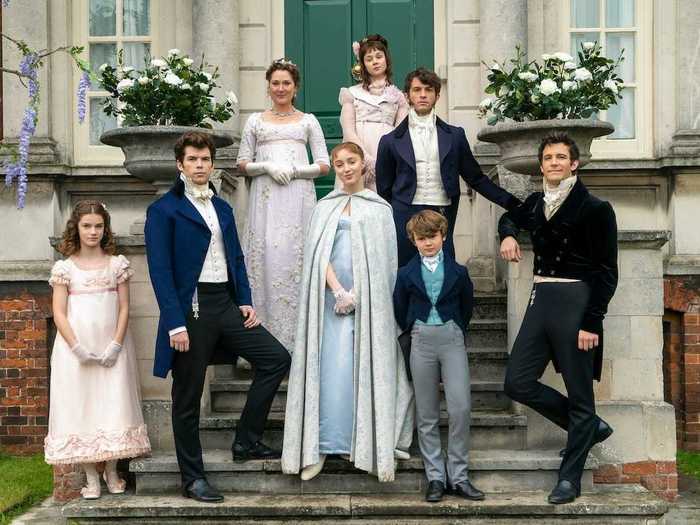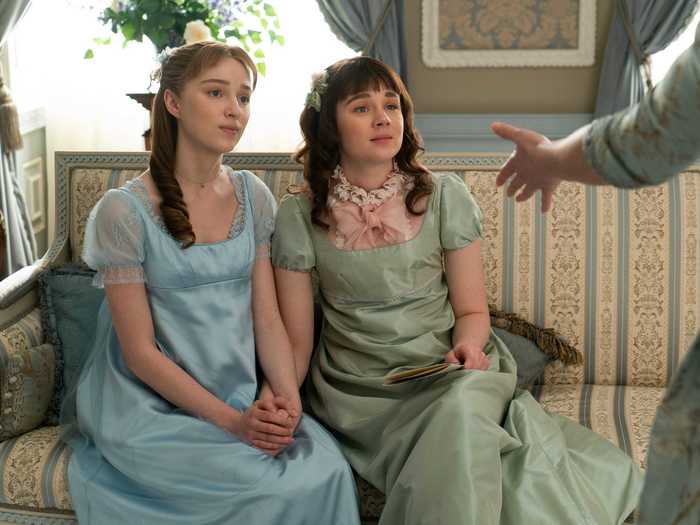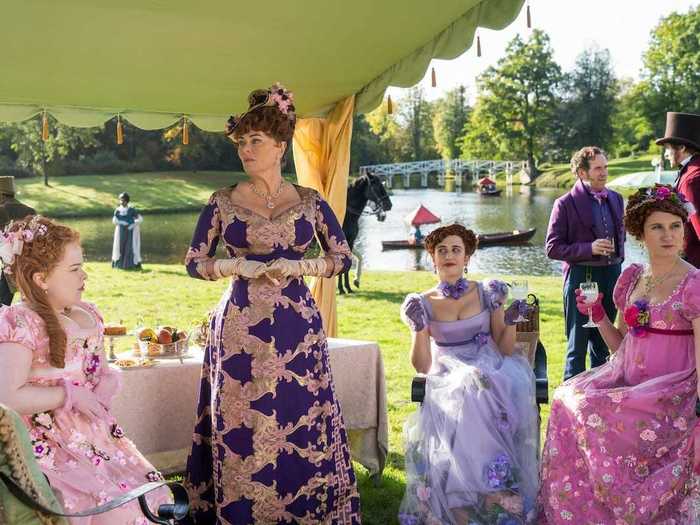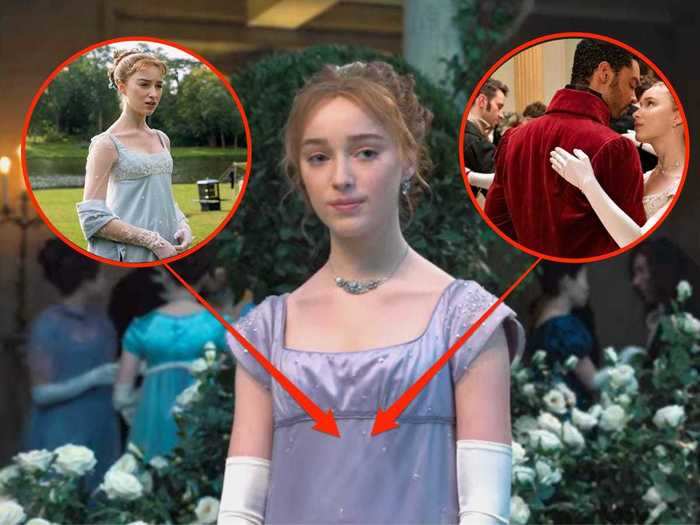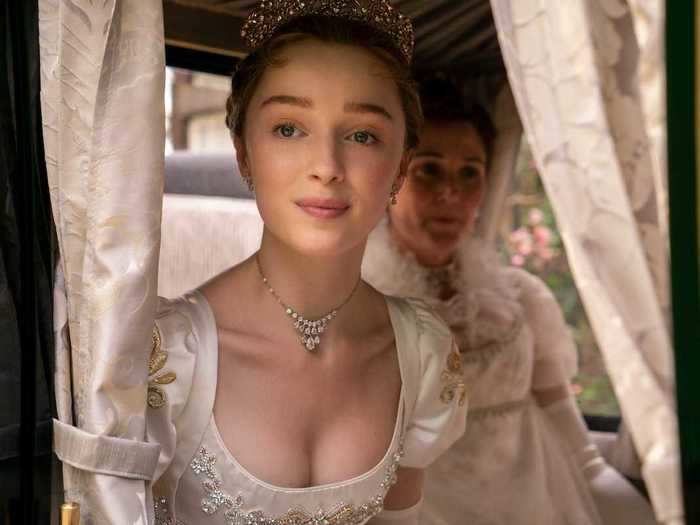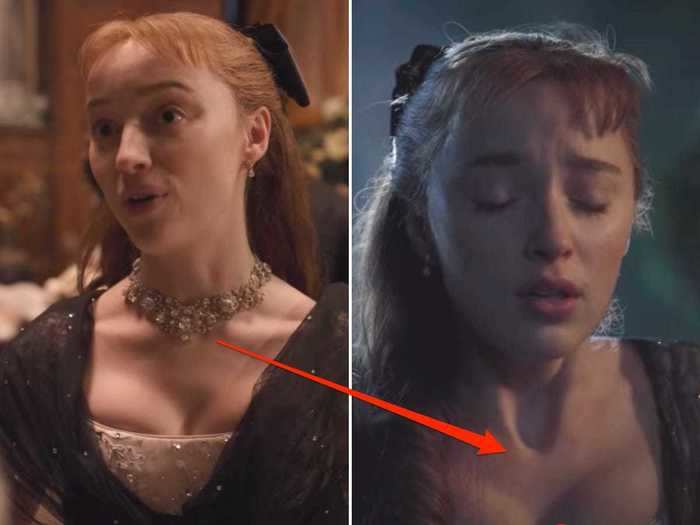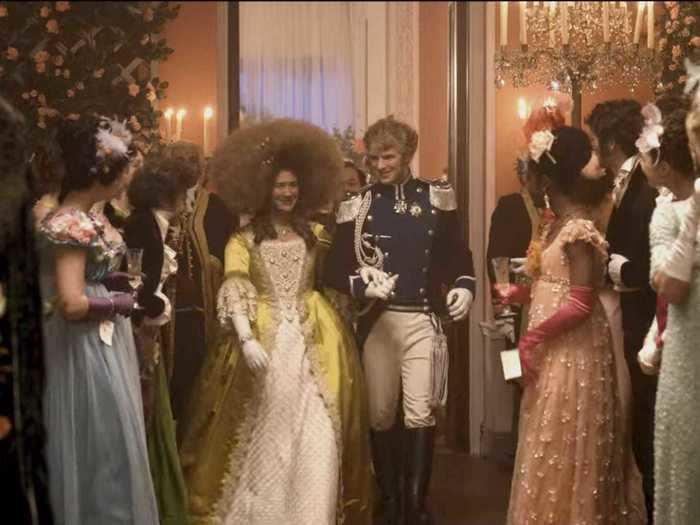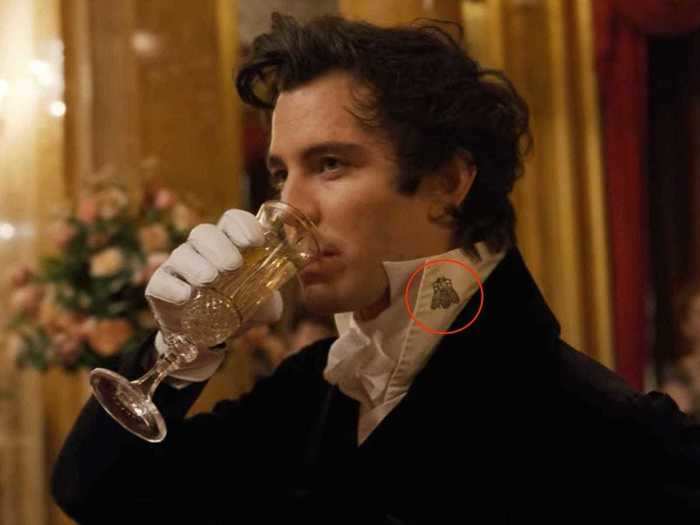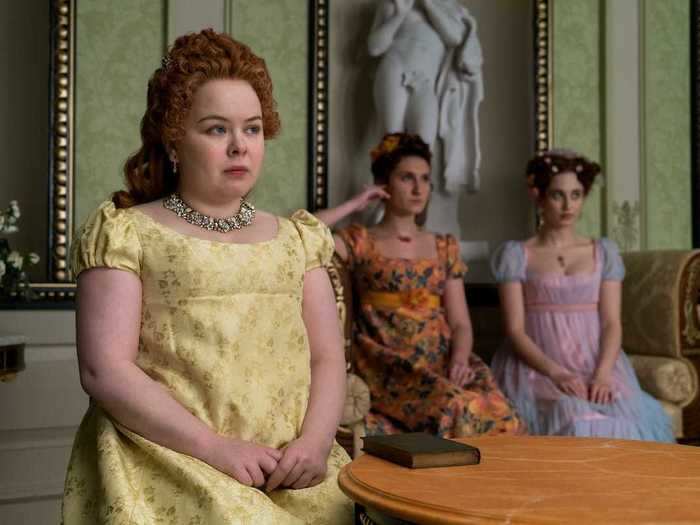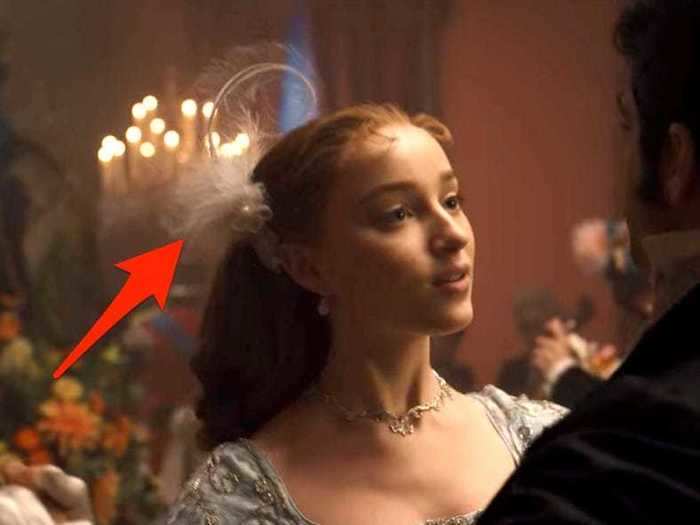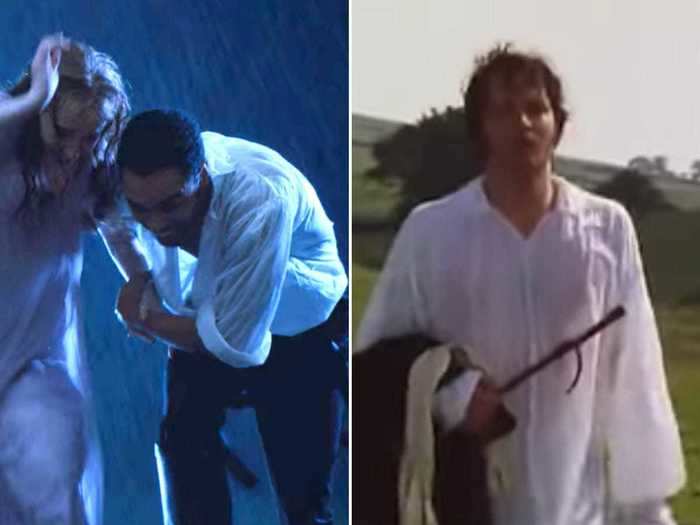Ellen Mirojnick, right, fits Phoebe Dynevor in a dress.Daniel Liam/Netflix
- The new original series, "Bridgerton," produced by Shondaland and created by Chris Van Dusen, has taken Netflix by storm.
- With 63 million households tuning in, people have been captured by the show's steamy plotline, character development, and, of course, the extravagant fashion.
- Some of the fashion choices also have hidden meanings that viewers might have missed.
- Warning: Spoilers ahead for season one of Netflix's "Bridgerton."
Netflix's new original series, "Bridgerton," is full of steamy plotlines, whimsical balls, exhilarating gossip, and sensational fashion.
The show, which was adapted from Julia Quinn's bestselling novels, follows the social season in Regency London, and so far more than 63 million viewers have tuned in.
Produced by Shondaland and created by Chris Van Dusen, "Bridgerton's" focus is on matchmaking, but the audience is also delighted by the show's fashion.
"Bridgerton's" wardrobe doesn't mimic the exact clothing and style choices of 1813 Regency London. Instead, costume designer Ellen Mirojnick referenced color palletes, fabrications, and silhouettes from the 1950s and 1960s, according to Vogue.
"I looked at the Regency period in London through drawings and paintings. We got a flavor of it and then it was about looking at the different silhouettes and shapes while knowing that this had to be aspirational, as opposed to historically accurate," she told Vogue.
By the end of the season, over 7,500 costume pieces were designed and created - some embedded with hidden meanings.
As Insider's Claudia Willen reported, each family has a specific color pallet they wear throughout the show.
The Bridgertons.
Liam Daniel/Netflix
Throughout the season, the audience is introduced to different families and their styles.
By the end of the season, it's clear that each family takes its own approach to fashion and colors, as Insider's entertainment reporter Claudia Willen noted.
The color choices were intentional, and the hues the families wear reveal hidden things about each family.
For the Bridgerton's, the pale blues, greens, and silvers showcase the family's societal standing.
Daphne Bridgerton and Eloise Bridgerton on "Bridgerton."
LIAM DANIEL/NETFLIX
In nearly every episode, the Bridgertons are spotted wearing subdued colors.
There are plenty of pale blues, greens, and silvers, along with a pale pink from Eloise Bridgerton (played by Claudia Jessie) every now and then.
"They're the prominent family of the social season so we wanted their color palette to be powdery — these pale blues, silvers, and greens that feel like whispers of color," Mirojnick told Vogue of the Bridgertons.
These pale colors symbolize the family's class and standing.
Additionally, production designer Will Hughes-Jones told Southern Living that the most common blue worn by the Bridgerton's is Wedgwood Blue.
This shade of blue was commonly found in English fine china at the time and strengthens the notion of class.
The Featheringtons, on the other hand, adorn bright shades of yellow, pink, and green, which symbolize that they're outsiders.
The family wears bright, bold hues throughout the show.
Liam Daniel/Netflix
The Featheringtons wear the brightest of colors throughout the season.
The mother, Portia (played by Polly Walker) is not afraid of color and adorns herself and her daughters in bold pinks, purples, greens, and yellows.
"[Portia] sets the tone for them as a family, and their color palette is overly citrus because she wants those girls to be seen. It might be too much, but that's not on purpose. She thinks they look beautiful," Mirojnick told Vogue
Meanwhile, it was a purposeful decision made by Mirojnick to deck the women in head-to-toe bright, bold colors.
The decision is designed to represent the family's new money and further signifies they're outsiders of the upper-class.
Simon Basset is often spotted wearing red and gold, which is a nod to the book the show is based on.
Simon wearing a gold and black vest.
Liam Daniel/Netflix
As Willen previously reported for Insider, the Hastings family's color pallet is red and gold, which is described in Quinn's book "The Duke and I."
This small detail was carried into the show, where viewers often spot Simon Basset (played by Regé-Jean Page) wearing these colors of royalty.
Simon is also spotted wearing many dark colors, which could also symbolize his troubled past.
After Simon and Daphne marry, Daphne starts wearing purple, a blend of her family's and Simon's colors.
Daphne wears a purple gown in the final episode of "Bridgerton."
Netflix
Once Daphne Bridgerton (played by Phoebe Dynevor) and Simon are officially married, Daphne begins wearing shades of purple.
This color shift symbolizes the shift she's experiencing in real life. By mixing blue (her old color) with red (Simon's color), she gets purple.
The color indicates she's slowly starting her own family.
The scooped necklines were designed to enhance the show's sexiness and playfulness, Mirojnick told Vogue.
Daphne wears a gown with a scooped neckline.
Liam Daniel/Netflix
Mirojnick told Vogue that she intentionally used scooped necklines as opposed to dresses with straight lines or high necks throughout the show.
This decision was made to help the characters seem sexy, fun, and playful.
"We paid a lot of attention to the scooped necklines and how they fit the bust, as opposed to having a straight line that doesn't allow you to see the body," Mirojnick told Vogue. "This show is sexy, fun, and far more accessible than your average restrained period drama, and it's important for the openness of the necklines to reflect that."
The removal of Daphne's necklace symbolizes the end of her and Prince Fred's relationship.
Daphne rips the necklace off in episode four.
Netflix
In episode four, Daphne wears a sparkling necklace gifted to her by Prince Friedrich (played by Freddie Stroma).
At the ball, Daphne is spotted running out into the moonlit garden where she rips the necklace off.
The Duke of Hastings, Simon, meets her outside where a scandal occurs.
Reddit user Society101 noticed the intentional removal of the necklace. The necklace is never mentioned again, but it symbolizes Prince Friedrich.
And the jewelry's removal foreshadows the end of their relationship.
"It has become clear that the necklace represented the prince himself, an extremely valuable gift that was tossed to the side for no other reason except it wasn't the right fit for Daphne no matter the beauty," Society101 wrote.
According to Insider's Willen, Queen Charlotte's hairstyles reference her role as England's first mixed-race royal.
Queen Charlotte entering the ball in episode three.
Netflix
In episode three, Queen Charlotte, played by Golda Rosheuvel, wears an enormous afro to one of the balls.
This hairstyle was intentionally chosen to symbolize Queen Charlotte's background, as historians believe she was England's first mixed-race royal, according to Insider's Willen.
Benedict's embroidered bees are a reference to his father.
Benedict on "Bridgerton."
Netflix
Per Insider's Willen, the bee is an important symbol throughout "Bridgerton."
The show doesn't explain how Edmund Bridgerton died, but according to Quinn's novels, Edmund died of a bee sting.
The show is filled with bee references, and a real bee brings the series to a full circle, with both the opening and ending scenes fixated on the insect.
Another bee reference is found in Benedict Bridgerton's wardrobe. Benedict (played by Luke Thompson) is spotted with embroidered bees on his coat and collar.
This bee is yet another reference to the son's father.
Penelope's yellow dresses represent everything from cheerfulness to caution.
Throughout the show, Penelope is constantly spotted in yellow.
Liam Daniel/Netflix
Penelope (played by Nicola Coughlan) is almost always spotted in bright yellow.
Although Penelope admits she doesn't even like the color, the bright hue offers many insights into the character.
First off, yellow is often associated with cheerfulness, optimism, and warmth — all things Penelope seems to embody when we first meet her.
Her kindness to Marina Thomspon (played by Ruby Barker) when the other Featheringtons begrudgingly took her in is just one of the many examples of Penelope's positivity.
But yellow also signifies caution. It's a sign that characters and the audience should be wary of Penelope.
When the show reveals she's Lady Whistledown, it's apparent that the characters should've been cautious of what they said and told Penelope throughout the show.
Another potential symbol Insider's Willen noticed was the feather in Daphne's hair in episode three.
Daphne wears a feather in her hair.
Netflix
Throughout the season, there is an abundance of feathers. They're stitched onto clothes, added into hairdos, and waved like fans. But in episode three, birdcages also appear with these feathers.
Insider's Willen reported that these birdcages and the feather Daphne wears in her hair could be a metaphor for how women were confined by society's rules in the 19th century.
At the ball, which the cast and crew aptly nicknamed "The Bird Ball," Daphne dances around a room filled with birdcages, peacocks, and songbirds.
The birds represent the women, and the cages are the rules of society.
Later in the season, another reference strengthens this metaphor.
"I've never understood the fashion for feathers in the hair," Eloise says to Penelope in episode five. "Why would a woman want to draw more notice to the fact that she's like a bird squawking for a man's attention in some bizarre ritual?"
Many of 'Bridgerton's' racy scenes were inspired by the soaked shirt scene in 'Pride and Prejudice.'
Both "Bridgerton" and "Pride and Prejudice" feature a wet-shirt scene.
Netflix/BBC
Creator and showrunner Van Dusen told the Los Angeles Times that the 1995 BBC TV adaptation of "Pride and Prejudice" influenced some of the show's racy scenes.
"Obviously, Colin Firth coming out of that lake with the white shirt is seared in my mind," Van Dusen told the Los Angeles Times. "But I wanted to see a period piece that went further than that."
The closest replication might be in episode six when Daphne and Simon celebrate their honeymoon outside in the rain.
Simon is spotted wearing a white button-down, just like Mr. Darcy in "Pride and Prejudice." Darcy's is soaked from the lake and Simon's from the rain. Both scenes capture sexual tension, while Van Dusen's show successfully takes it further.
